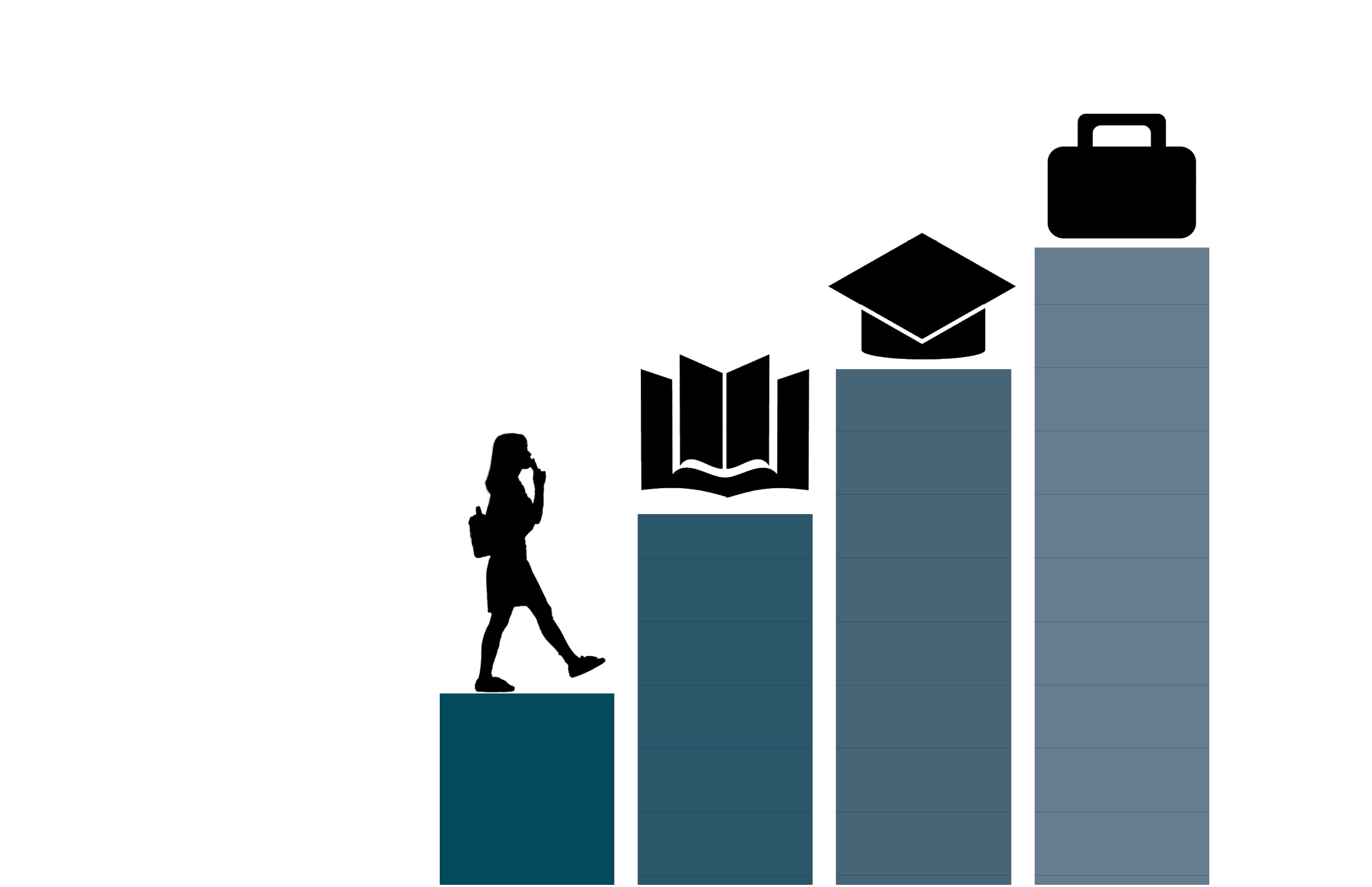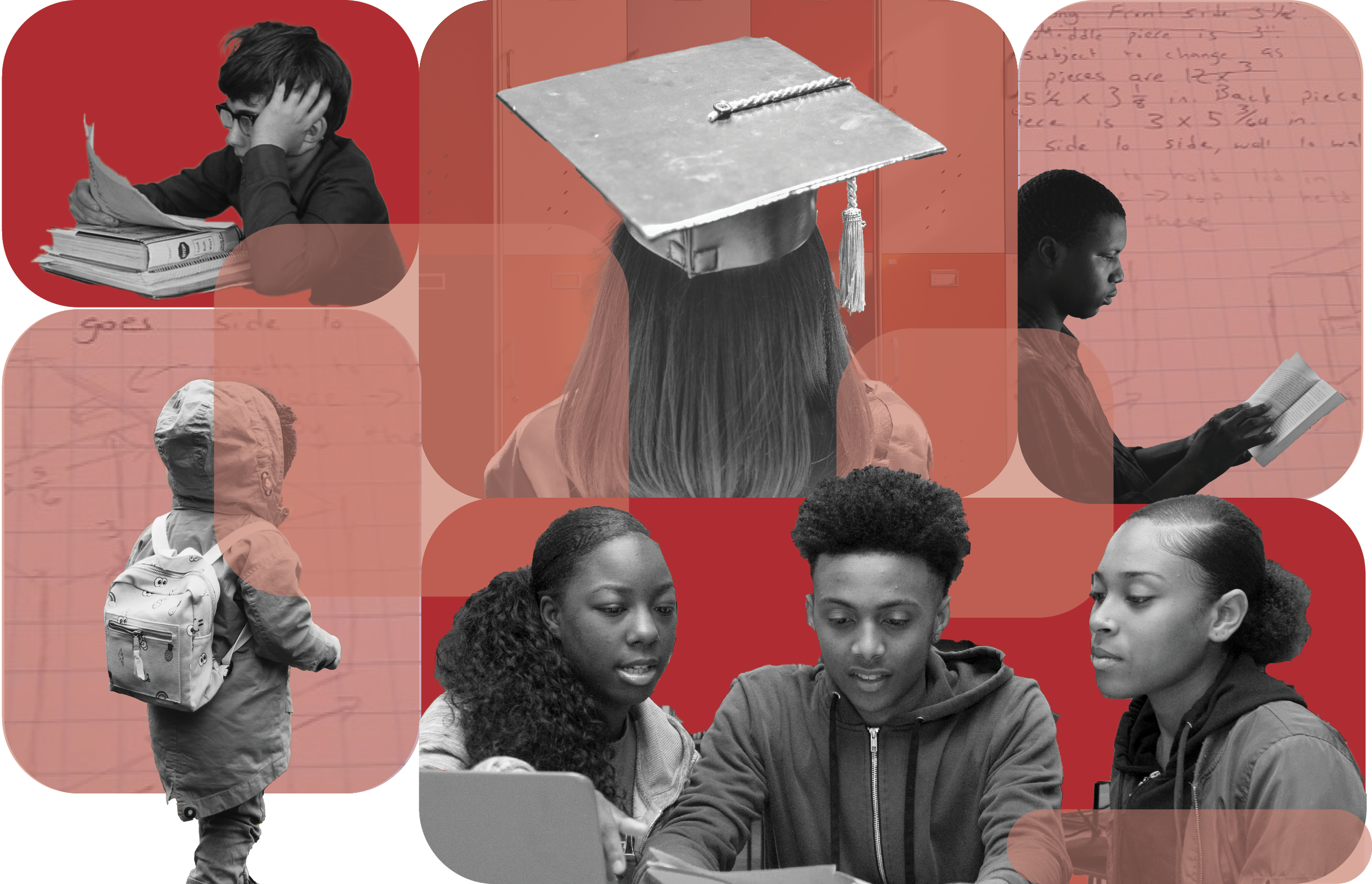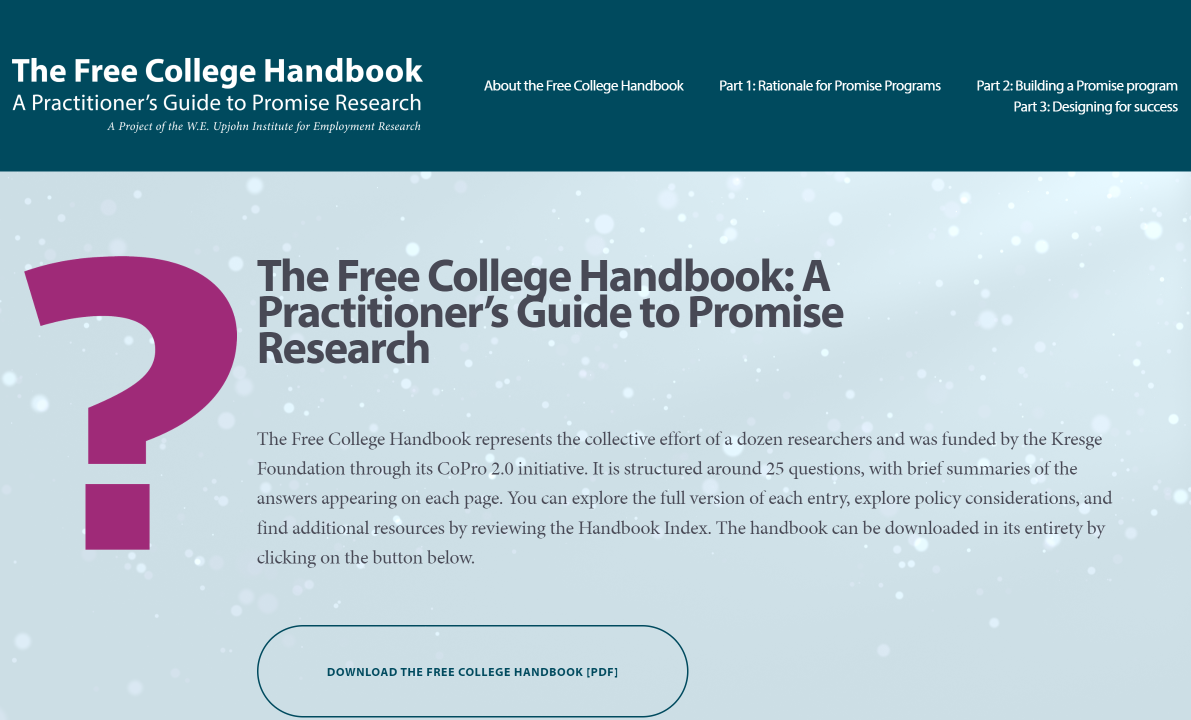Tuition-free college programs succeed when they move beyond scholarships to guide students past common college roadblocks, link students with employers, and meet the needs of adult learners.
by Bridget Timmeney & Alfonso Hernandez

Illustration by Kathleen Bolter; photographs by Andrea Piacquadio, Evg Kowalievska, Photolover Riga, and Dmitry Limonov via Pexels.
A wave of place-based, tuition-free scholarship programs were launched following the announcement of the Kalamazoo Promise in 2005. More than 220 place-based scholarships (or “Promise” programs) have since been created to support students on their postsecondary pathways. Over the past two decades, Promise programs’ significant growth is reflected not just in their numbers, but also in their scope and purpose of programming. What was once a movement to equalize financial access to postsecondary training and education is now expanding to ensure student progression and completion. Additionally, program goals for recent high school graduates increasingly extend beyond degree and certificate attainment to also provide workforce connections and work-based experiences, with adult programs becoming an integral part of the mix.
Beyond Financial Assistance
Providing students with new financial resources is not always enough to change their paths after high school. Designers and administrators of Promise programs have learned that the greatest impact occurs when they combine new financial resources with proven forms of student support such as intrusive coaching, cohort-based first-year courses, integrated developmental coursework tutoring, priority registration, and career awareness and readiness coaching. Some programs accomplish this through intense collaboration with community partners, including higher education and business. Examples of this model include the Say Yes to Buffalo program, which partners deeply across many sectors, and the Columbus Promise, which partners with the local I Know I Can organization, an organization that works in partnership with the local public schools. Other programs, such as the Kalamazoo Promise, embed this type of support with internal staffing. Sometimes, such as in the case of the Richmond Promise, programs mix both approaches to reduce barriers and meet students’ broader needs for success.
Students, especially first-generation or low-income college goers, need support in navigating both the academic and nonacademic challenges of college. Promise programs have drawn on evidence-based strategies for supporting students, such as academic and personal coaching, case management, and the use of predictive analytics to improve retention and completion. These strategies seek to reduce or eliminate hurdles students must overcome to enroll, persist, and complete college. One such model is the Accelerated Study in Associate Programs (ASAP) model, based at the City University of New York (CUNY), which has served as a model for some Promise programs’ support components. CUNY ASAP offers personalized academic and career advising, a summer institute, cohort-style courses with convenient scheduling, and financial support (e.g., tuition/fee waivers, textbook assistance, and transportation). The program has nearly doubled three-year associate degree completion rates. The ASAP model has been replicated successfully (with modifications) in other locations, as well as with the Detroit Promise, where the replication generated mixed results.
As Promise programs expanded, stakeholders increasingly acknowledged the importance of comprehensive program design with these supports included in the funding structure. Without these more comprehensive components, programs were experiencing a growing population of Promise “stop outs”—students who start a postsecondary pathway but don’t finish because of a variety of possible reasons: the need to work more hours interfering with school, child and family care needs, lack of academic and/or college knowledge preparedness, and lack of peer and/or institutional supports for navigation.
Building Workforce and Education Connections
Over time, Promise programs expanded their objectives beyond degree completion, prioritizing career development, internships, and job search assistance to promote economic mobility. Securing gainful employment remains a challenge for some Promise students, particularly for first-generation students and students of color; the absence of preexisting social networks and work experience can limit employment options, even for graduates with skills and credentials. Meanwhile, many businesses have expressed a genuine desire to diversify their workforce and consider Promise programs as representing a potential avenue, but they have faced difficulties in meaningfully engaging through conventional channels. Successful strategies to build workforce and education connections must address both the student needs and a diverse set of businesses.
The Kalamazoo Promise, for example, was originally launched in 2006, but its internship component, Higher Promise, did not start until 2022. The initiative connects students to high-quality, paid summer internships at regional businesses by matching student interest (and major) with businesses’ needs. For the Higher Promise, it is about culture building. Higher Promise programming includes work readiness supports for students prior to and throughout the internship. Higher Promise scholars receive support in resume development and interview preparation at the outset. Then, as interns, they participate in a professional development course led by Kalamazoo Promise staff and community partners throughout the internship. This results in a project report and presentation at the end of the internship. Peer networking, summer social mixers, and being paired with a mentor are intended to help scholars grow professionally and to facilitate the development of a professional network. Meanwhile, business partners engage to grow talent locally with the aim of diversifying their workforce, and Kalamazoo Promise staff host business-focused workshops to share best practices in internships, diversity, and inclusion, with the goal of integrating interns most effectively in the work culture.
Adult Learners and Promise Programs
In response to an increasing demand for a skilled workforce, 45 states have set targets to boost the number of individuals statewide who have a credential. For example, Michigan’s Department of Labor and Economic Opportunity established the “Sixty by 30” program, with the goal of boosting the percentage of working-age adults with a credential from 51.1 percent to 60 percent by 2030.
Promise programs are in a unique position to partner with these statewide initiatives by offering pathways for adults to enhance their skills and competitiveness in the job market. One example of such a collaboration is found in Tennessee, where TN Promise and TN Reconnect both provide financial resources toward degree attainment and a workforce network of community/industry partners that mentor students. While TN Promise focuses on guiding high school students through college and career exploration and placement, TN Reconnect—started four years after TN Promise—caters to adult learners who have not yet received a degree, offering tuition-free access to community or technical college and career guidance. According to a study published by the Tennessee Comptroller of the Treasury, compared to non-Reconnect students, Reconnect students are more likely to earn workforce-ready credentials for state-designated high-demand jobs. This suggests that combining financial assistance with career guidance may be a worthwhile strategy. Both programs are bolstered by Tennessee’s “Drive to 55 Alliance,” which includes partners from the private sector, community leaders, and nonprofits, who support both traditional and adult learners through mentorship, career exploration, and placement efforts.
The evolution of Promise program design highlights the importance of adapting college success initiatives to meet the needs of students, employers, and local communities. Although lack of money is a key challenge, it is hardly the only difficulty in connecting students—both students of traditional college age and adult learners—to greater economic opportunity through better jobs. As programs have grown to appreciate the importance of college navigation, career networks, work experiences, and local employer demand, they have pivoted to trying to build the partnerships needed to achieve these broader goals.
Policy Recommendations
• Promise programs can combine scholarships with other guidance and assistance to bolster student success. This can include academic and personal coaching, case management, and comprehensive assistance in addressing both academic and nonacademic challenges students face in college. However, these navigation supports come with a cost, which funders need to provide for as integral components of Promise programs.
• Promise programming has highlighted a broader need for tighter alignment between higher education and business and industry. A tighter connection which supports student learning, ties learning to industry standards and content and facilitates work-based learning is mutually beneficial. Promise programs increasingly recognize this need to provide career guidance and facilitate work experience and internship opportunities and increasingly serve as an important link between business, education and student needs.
• States are increasingly emphasizing the importance of credential attainment among adult learners. Some have developed Promise programs for adult learners that waive tuition and fees. States also are trying to redesign admission and support services to remove some of the barriers adults face in completing career-readiness programs.
Authors





